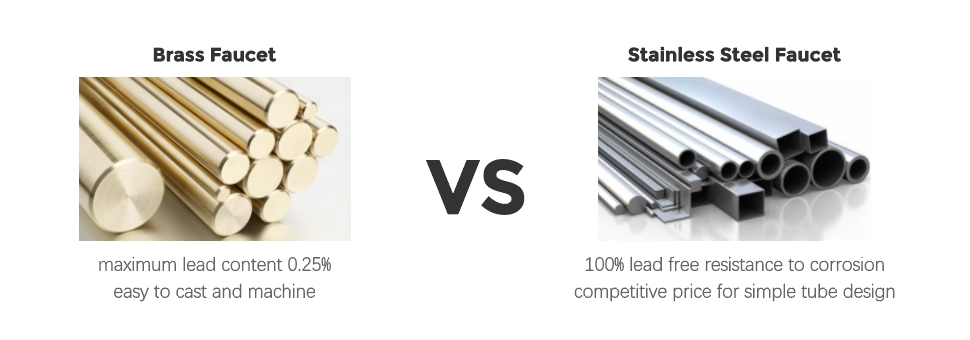Material Composition (The Technical Stuff)
Brass is an alloy metal made of mostly copper and zinc. The composition can range anywhere between 50-63% copper and 50-37% zinc, with other additives used for material malleability. There are many manufacturing methods used to create brass hardware, including wrought, forged, cast, and die-cut processes. Since it has a relatively low melting point, it’s easier to cast and is soft enough to machine with little effort yet hardy enough to endure the rigors of life as a faucet. One of the main issues with brass faucets is that they’re not 100% lead-free. It used to be a common practice to add lead to brass for malleability purposes, but now it’s been virtually banned for use in faucets and most other plumbing fixtures. Before 2014, a faucet could contain as much as 8% lead and still call itself lead-free. Now the maximum lead content in a faucet is 0.25% (1/4 of 1%) according to NSF standards. To comply with the restrictions on lead, today’s faucet brass is “lead-free” brass that uses other additives for malleability.
304 and 316 stainless is another material option used for faucets. These stainless steel options contain 18% chromium and 8-10% nickel, the nickel giving the steel a particular crystalline structure to increase the material’s strength and malleability while the chromium helps the steel resist corrosion. Both materials are austenitic steels, which means they are low- or non-magnetic. Stainless 304 is by far the more commonly-used alloy for making faucets, which is what our Lulani stainless steel faucets are made of. Stainless 316, known as marine grade stainless, has superior resistance to pitting, corrosion, and staining, particularly in acidic or salt environments, but comes in second behind Stainless 304 due to its hardness and manufacturing difficulty level. In general, stainless steel is harder than brass and has a higher melting point, making it more difficult than brass to cast and machine. However for some basic designs of faucet like simple round and square shape, faucets that made of stainless steel are more easier and cheaper than brass as there are existing semi-finished tube material for cutting and machining.

Benefits
Brass fixtures are more malleable than steel or iron. This means it’s easier to bend, shape or mold fittings to suit your needs than most other metals. Stainless steel, on the other hand, is considered a step above brass. Its physical durability exhibits longevity that other materials cannot muster. It has natural heat-resistant properties that are considered corrosion-resistant, tarnish-resistant, and will not rust. This means it requires less maintenance since it’s scratch-resistant and will disguise spots and smudges.
Stainless steel is extremely hygienic. It’s a common material used in the food processing, hospital, and pharmaceutical industries due to its corrosion and rust-resistant traits. The stainless steel material used in faucets provides a smooth, easy-to-clean surface that will not produce small pores or crevices where bacteria may otherwise harbor. Its naturally occurring properties can be very attractive features to a plethora of industries.
One of the most major differences between brass and stainless steel material is that stainless steel is 100% lead-free. All plumbing fixtures should be safe, but as we mentioned earlier, some materials contain a minute amount of lead. Stainless steel doesn’t, so you can rest assured it won’t release lead into the water that comes out of the faucet.
Trend
Brass fixtures are more malleable than steel or iron. This means it’s easier to bend, shape or mold fittings to suit your needs than most other metals. Stainless steel, on the other hand, is considered a step above brass. Its physical durability exhibits longevity that other materials cannot muster. It has natural heat-resistant properties that are considered corrosion-resistant, tarnish-resistant, and will not rust. This means it requires less maintenance since it’s scratch-resistant and will disguise spots and smudges.
Stainless steel is extremely hygienic. It’s a common material used in the food processing, hospital, and pharmaceutical industries due to its corrosion and rust-resistant traits. The stainless steel material used in faucets provides a smooth, easy-to-clean surface that will not produce small pores or crevices where bacteria may otherwise harbor. Its naturally occurring properties can be very attractive features to a plethora of industries.
One of the most major differences between brass and stainless steel material is that stainless steel is 100% lead-free. All plumbing fixtures should be safe, but as we mentioned earlier, some materials contain a minute amount of lead. Stainless steel doesn’t, so you can rest assured it won’t release lead into the water that comes out of the faucet.